The LG V60 and VELVET Review: A Classic & A Design Restart
by Andrei Frumusanu on July 15, 2020 9:00 AM ESTDisplay Measurement - Typical LG
We mentioned that we have a high suspicion that the V60 and Velvet screen panels are identical, even though there’s a different shape cover glass over both. One further difference between the two phones is their software calibration. The V60 comes with LG’s classic wide range of display profiles (Auto, Cinema, Sports, Game, Photos, Web, Expert) that we’ve seen introduced over the last few years, whilst the Velvet has more significantly simplified things down to only three presents as a custom option (Natural, Vivid, Cinema, Custom).
For the V60, LG’s most accurate preset which actually targets an sRGB gamut is the “Web” profile and that’s what we tested here today. On the Velvet, it unfortunately looks like LG dumbed things down a little too much, as the phone no longer has any profile that’s able to target an sRGB gamut, with all of the available presets targeting some larger colour spaces. We’ve left it on the “Natural” mode as it gave a good enough white-point out of the box.
We move on to the display calibration and fundamental display measurements of the V60 and Velvet screens. As always, we thank X-Rite and SpecraCal, as our measurements are performed with an X-Rite i1Pro 2 spectrophotometer, with the exception of black levels which are measured with an i1Display Pro colorimeter. Data is collected and examined using Portrait Display's CalMAN software.

In terms of brightness, the new LG panels here don’t fare all too well in terms of their maximum brightness. In manual mode, both phones do get brighter than what we typical see of Android OLED devices at around 485 cd/m², but the auto mode under bright environments doesn’t raise this figure much at all, only reaching 525-550 cd/m² on both phones. The auto mode does change the colours and improves contrast for legibility, but can’t really compete with the newer generation Samsung AMOLED panels in terms of brightness.

 Portrait Displays CalMAN
Portrait Displays CalMAN
LG V60
Moving on onto greyscale testing, the LG V60 has some large problems in terms of properly tracking a correct gamma curve. The mid-levels are far too dark, beyond reasonable error rates. The good news is that the colour balance and temperature on the phone is quite good and reaching whites and average colour temperatures of 6600K – a little bit cooler over the 6500K natural sunlight white target, but I prefer this to say Samsung’s usual too warm colour tones.
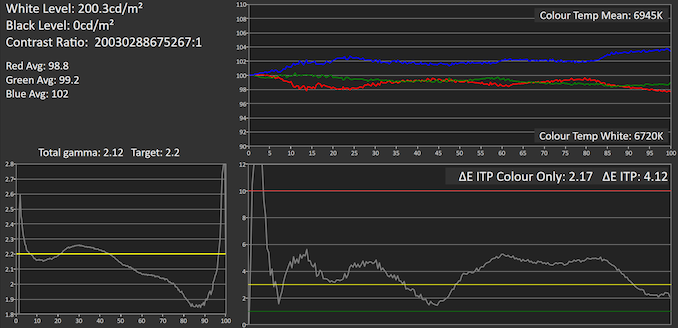
 Portrait Displays CalMAN
Portrait Displays CalMAN
LG Velvet
The LG Velvet’s greyscale results also have issues with the gamma tracking, but this time around it’s on the upper levels where it’s showcasing too low gamma, resulting in tones being brighter than they should be. The Natural colour profile here is also more noticeably cooler, with an average colour temperature of 6945K. It’s possible to fine-tune the colour temperature in the custom settings to alleviate this if it’s a bother.
In the saturations against an sRGB gamut, we see the LG V60 fare quite well when it comes to just the colours themselves. The phone’s biggest issue here is the aforementioned handling of the gamma, resulting in the tones being far too dark.
On the Velvet, as the phone doesn’t actually have a native accurate sRGB mode, it means that all the targets here are way off mark as the “Natural” gamut doesn’t correspond to any particular colour space. This also isn’t a P3 target as the blue hue is significantly different in hue – I don’t know precisely what LG is targeting here if they’re even targeting any standard at all.
In the GMB test with common test tones and colours, the V60 falls flat on its face as the results are outright disastrous. This isn’t too much of a surprise as LG has a long history of making a complete mess of their display colour calibrations in their phones, and the V60 is unfortunately just a continuation of that tradition.
The Velvet, oddly enough, actually fares quite well in the GMB test even though it really shouldn’t be given its non-sRGB gamut. The biggest noticeable difference in the comparison palette is that many of the patches are brighter than they should be, which again points out to the lower than should-be gamut calibration.
Overall, both phones are very clearly LG phones and their colour calibrations are amongst the worst in the market right now. The V60 in particular has just atrocious results given that this was supposed to be an accurate “Web” profile targeting the sRGB space. It’s really unfortunate what the company did here, but after so many years of seeing repeated disaster after disaster, I’ve just come to accept that LG phones simply won’t ever have accurate colours, as sad as that sounds.


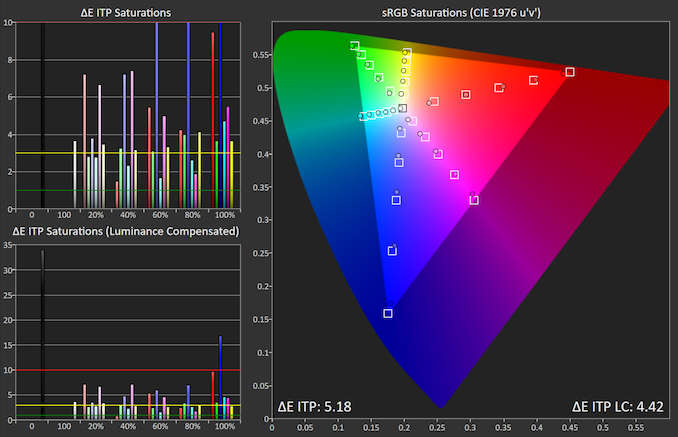
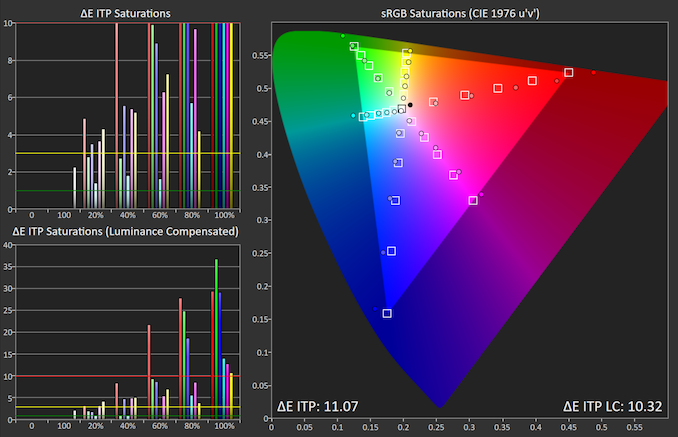
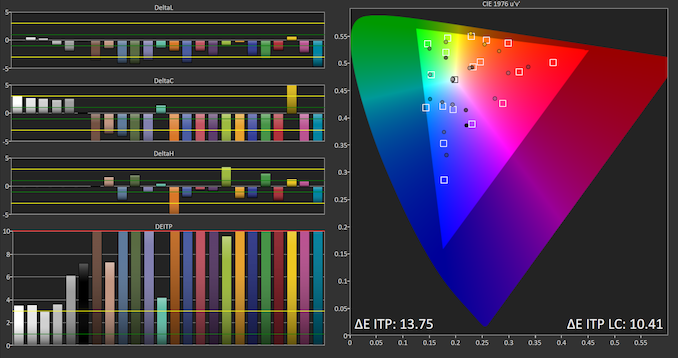

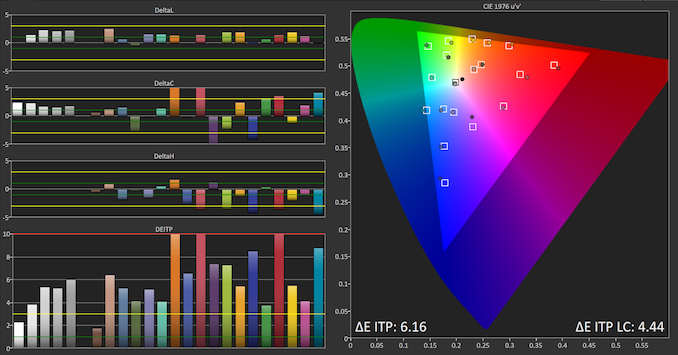









81 Comments
View All Comments
PeachNCream - Thursday, July 16, 2020 - link
Basically that Notebookcheck is better for comparing things to other things than Anandtech - which is true. If I want to kill time reading meandering articles about hardware I will never own, I read AT. If I want to research a product I actually do intend to buy, Notebookcheck is where I go first to get to the actual point.s.yu - Thursday, July 16, 2020 - link
Yup, with the exception that their battery tests are updated from time to time so you won't get apples to apples battery numbers between equivalent devices across generations, say S20 and S7, which was what psychobriggsy suggested.s.yu - Thursday, July 16, 2020 - link
lol, I don't get what you're not getting.ack68 - Wednesday, July 15, 2020 - link
I received two v60's free from AT&T when we switched from Sprint. Also received the dual screens for free as well. Using the dual screen all the time can kill your battery within 4hrs. The only irritating thing is if you have it in landscape view, you can accidentally touch the corners of the screen and select whatever is in the corner where you touched. Other than that, it's all good.Quantumz0d - Wednesday, July 15, 2020 - link
No mention of the ESS Quad DAC in the V60 no need to even test but just a mention of them would be good, just a simple one line mention it takes, LG upgraded the DAC chip to ESS9219 from 9218 which was in V30 to V50. And Android 11 destroys the DSD playback. And no mention of the LG's Audio recording modes available in the camera mode either it has HiFi options with Filters for recording in 192KHz with 24Bit in FLAC and Audio playback also has Filters from the DAC directly, same for Pro camera video modes which LG and Sony only offer as well.And vs OnePlus no other features mentioned at all, what about SD slot ?
Until Apple brings the Pro Video, I think no one even gives a shit about those. All shiny toy things and camera output, that's all matters I guess, every review same mainstream talk.
Quantumz0d - Wednesday, July 15, 2020 - link
Color accuracy, no ones gives a shit about them tbh. Look at Samsung Ultra high saturated modes, people only use those. And 90Hz or 120Hz is not a pity at all, its a good option but at the expense of battery life with shitty non removable $1000 consumable piece is it worth ? Nope.SD card slot, Bootloader unlock, 3.5mm jack and stability of the OS, Software features - Camera modes those are the things which matters most so different sects of the audience.
brucethemoose - Wednesday, July 15, 2020 - link
I wouldnt trade 120hz for the world, though Android could use some VRR love.The DAC/ADC is a huge plus for the V series though. I'd love to see that in other phones, even if its only over USB C analog.
s.yu - Wednesday, July 15, 2020 - link
Sorry I've been on AMOLED Photo since I switched to Samsung, will be looking for something similar once I switch to some other brand from Samsung betraying the jack.mrbios - Thursday, July 16, 2020 - link
I agree with Quantumz0d, color accuracy isn't something that most people care about, especially when it comes to OLED screens. The Pixel 2 I believe it was, people were losing their shit when Google shipped those with a more accurate color profile, instead of one that "pops". Once they changed things to be ultra saturated, it was still worse than a Samsung AMOLOED panel, but people complained a lot less.And my mom, she had some cheaper Samsung smartphone, and she was complaining about how the photos she was taking looked like absolute crap. So, I got her a used OnePlus 3T for Christmas last year, since that was still better all around than what she was using. Once I transferred over the photos from her old phone, she was shocked at how amazing those photos suddenly looked! So, it really wasn't so much that the camera was bad on her old phone, it was that she was seeing those oversaturated colors on other OLED screens, and thought that the camera was the issue.
Only a couple of data points, but really, most people stick with the oversaturated colors on Samsung phones as well. So to most people, true color accuracy is meaningless, it's all about the colors that "pop" off the screen.
vanilla_gorilla - Wednesday, July 15, 2020 - link
"The LG Velvet comes in at 599€. Whilst the phone its generally good for its price-point, the biggest issue I have with these premium devices is that 90% of the time you’re just better off buying last year’s flagship phones."I feel like as difficult it as it is to get updates for a phone, chopping a year off that period of supported software is pretty painful. I'm really not interested in trying to load some custom version of Android, I just want a phone that works.